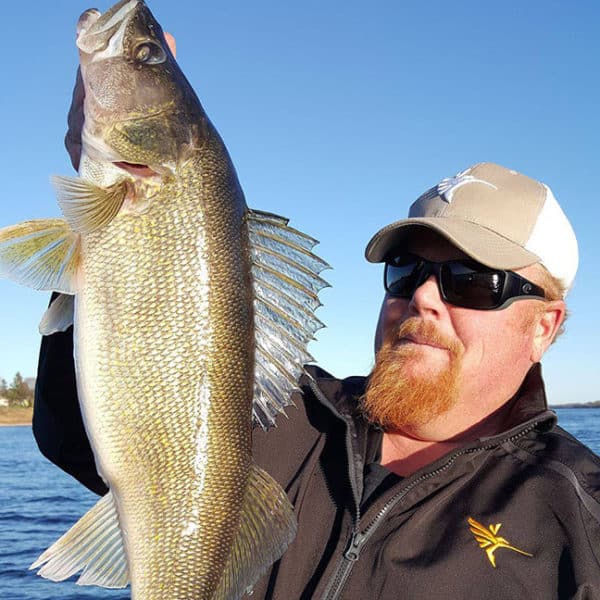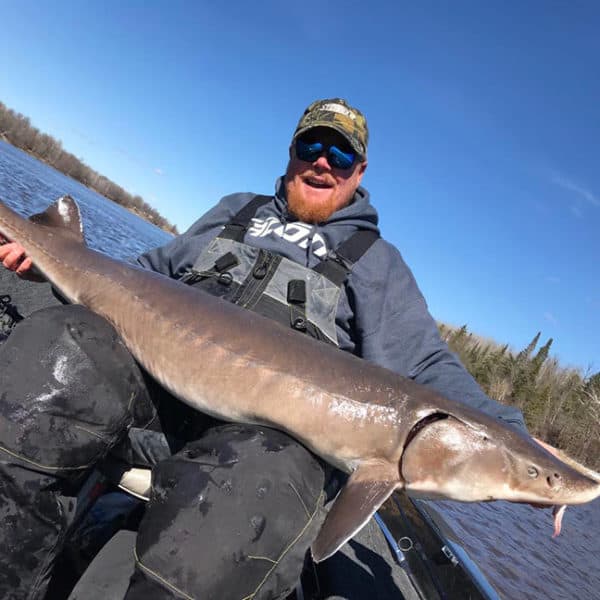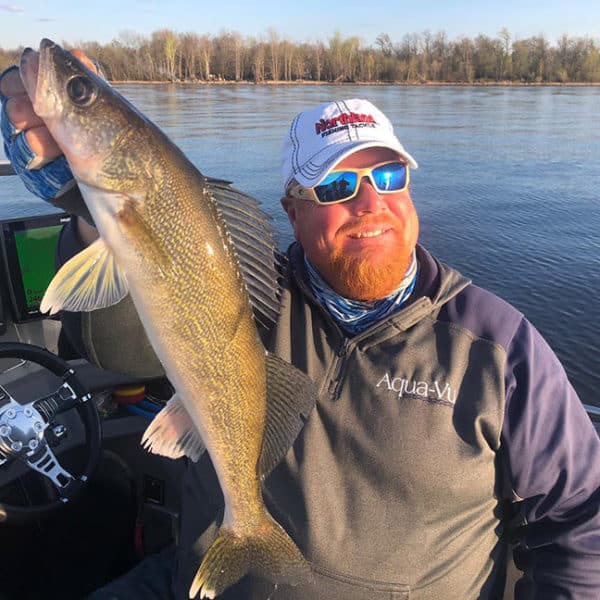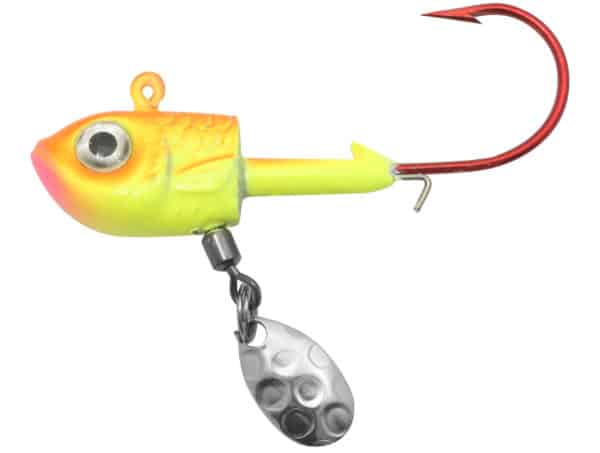Early-Season River Jigging
Category: article
Apr 2nd, 2022 by Keith Worrall
Modified Apr 2nd, 2022 at 12:26 PM

Northland pro and guide Brian “Bro” Brosdahl shares his top tips for more walleyes this spring
BEMIDJI, Minn. (April 1, 2022) – Winter is winding down as the days get longer and overnight temperatures rise. Ice fishing can reach into April, but ice-out on the rivers is what walleye anglers are really looking forward to.
The Rainy River and Mississippi River Pools 2, 3, and 4 have targets on their backs. The Rainy is catch and release only, while the Mississippi River Pools 3 through 8 offer a four fish bag with a 15-inch minimum and one over 20-inches. Fillets aside, most anglers just want to boat a walleye as a change of pace from pulling fish through the ice.
Anglers travel from across the Midwest to fish both the Rainy and Mississippi. It’s an annual tradition for many and a rite of passage from hardwater season to open water. And although we’re focusing on the Rainy and Mississippi, the following wisdom applies to volumes of rivers as walleyes gather and make upstream runs to spring spawning areas.

Deep-Vee Jig (Front View)
Jiggin’ for Walleye Success
“I like to bring a lot of different weapons in the early spring,” says lifelong river rat Brian “Bro” Brosdahl, “but the Northland Deep-Vee Jig is tops on the list. I think fish can see its oversized eyeballs from a distance, even in murky water. The Deep-Vee also has a seductive action and sideways tumble. For me, it’s ¼- and 3/8-ouncers. Rarely do I use less than a ¼-ounce unless the water conditions are unseasonably low due to lack of snow runoff and ice melt.”
He adds: “If you’re slipping the river working downstream, you can get away with a ¼-ounce jig. For Spot-Locking with an electronic trolling motor to stay in one position, the 3/8-ounce comes into play.”
Bro tips his Deep-Vee Jigs with a chub or live or frozen shiner and starts by tapping the bottom to determine depth. When downriver drifting, you don’t want to drag the bottom. If your line works upstream while drifting it means the jig is dragging bottom and likely to snag.
Bro recommends lifting the Deep-Vee and minnow six- to eight-inches off the bottom and using subtle movements or short, little hops. If you’re jigging too high, the bait can disappear from the fish’s view, especially in turbid water.

“Couple other jigs I use when locked and fishing one area are the Whistler Jig Neon and Thumper Jig. The Whistler Jig features a fish-attracting propeller right behind head. In some areas the current is going to want to whisk that jig away from bottom because of the propeller, but there’s a simple trick to maintain bottom contact. Drop it to the bottom—use a 3/8-ounce—just slow pump it, which moves the prop. Then drop it back to bottom, and if you don’t make contact, just let a little line out. I continually let out line after a few pulls. I call it ‘walking the dog’ downstream. But don’t let it get too far from the boat. You want it on a short leash to fight big fish,” notes Brosdahl.
“Thumper Jigs have a little spinner behind the head and bait keeper on the hook. The spinner makes a huge difference when walleyes are filing upstream along the bottom; draws their attention and makes them strike. The Thumper has a slender profile, slicing through the current, and the 3/8-ounce version is perfect for attaching a minnow and it stays on the bait keeper,” continues Brosdahl.
Bro carries rods pre-rigged with a Deep-Vee Jig, Whistler Jig Neon and Thumper Jig. There are times he notes that walleyes just want “dry toast with their breakfast”—a Deep Vee jig and no spinners. This really rings true when cold fronts pass through.
“One of my favorite colors—and I won’t go to the river without it—is Sunrise. It features great contrasting colors, and you’ll always find it on one of my rods.”
When asked about early-season jigging line preferences Bro is insistent in the sensitivity, visibility, and overall ruggedness of braid with a short fluorocarbon leader.
“Sometimes the river is super murky and sometimes it’s clear, but what I’ve found is that 10-pound test braid and an 8-pound fluorocarbon leader works no matter what,” advises Bro. “10-pound braid is super strong, so you need a breaking spot in the system in case you do get snagged. Otherwise, you run the risk of breaking a rod while downriver drifting.”
In terms of rods, Bro is a fan of a 7-foot St. Croix Legend Elite in medium-power and extra-fast action. On windy days he’ll downsize length to a 6-footer in the same family, power, and action. He matches the rods with a Daiwa Tatula 2000 reel.

Whistler Jig Neon (Sunrise)
Key Jigging Locations
You can cover a lot of water downriver drifting. Rolling sandbars seem to always hold fish but the corners and neckdowns often have the biggest schools of walleyes. Any kind of turn in the river with current seams will also hold fish. Sometimes, though, open stretches on the main river with few features and changes in the river channel depth also attract walleyes. Point being – plan to blanket a lot of river until a pattern is established.
The Deep-Vee Jig sports a keeled “DEEP-VEE” design that’s thicker on top and thin on the bottom to track straight and fall fast, even in current. It also features holographic, 3D eyes that exude a “match-the-hatch” realism. Whether fished with live bait or plastics, the Deep-Vee’s Barb-Wire® keeper makes sure your bait isn’t going anywhere.
Designed with a sleek minnow head and features a “thumper” belly blade that flickers, flashes & flutters to lure fish and entice ‘em to strike. Blood red “Lip-Stick®” wounded bait hooks stimulate the bite.
A specially designed Barb-Wire® bait-holding collar securely holds live bait and soft plastic trailers. Tip with live bait and soft-plastic trailers. Cast and retrieve or troll at a slow to moderate speed, slow-rolling, fluttering and raising the jig for extra attraction. Bursts of speed may also trigger strikes. Also great for vertical jigging and drifting.
The Whistler Jig’s unique “propeller” blade adds flash and sonic vibration to lure fish and trigger ‘em to strike. It’s high-visibility neon propeller blade colors are deadly in dark, stained and muddy water. Tip with live bait or soft-plastic trailers. Cast and flutter around weeds, rocks and wood. Also effective drifting, slow-trolling and vertical jigging.

Bro with a bonus lake sturgeon.


